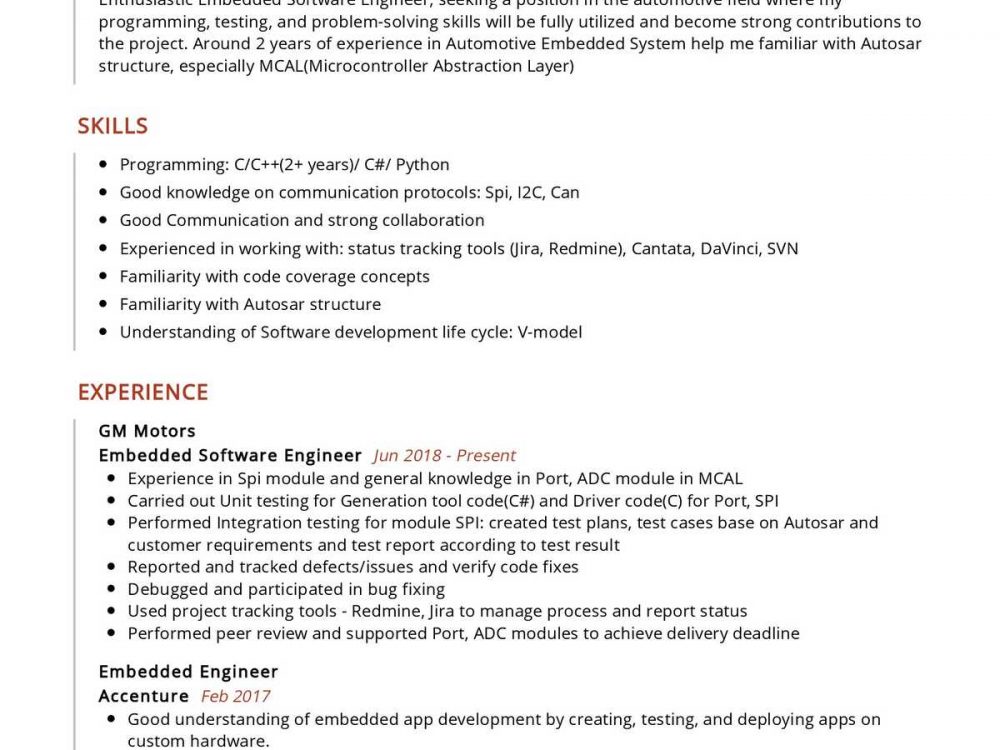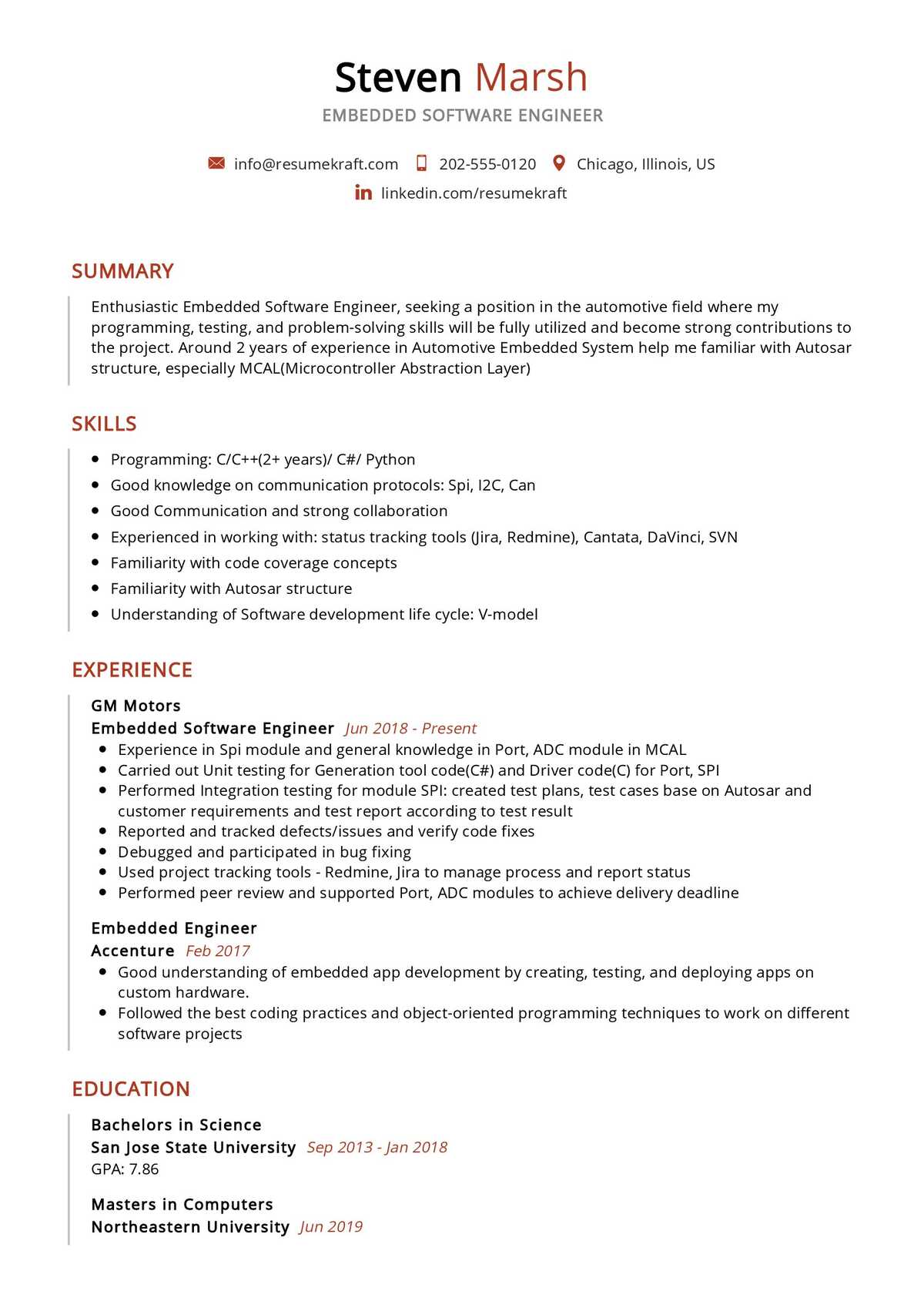Are you an Embedded Software by profession and looking for an exciting career? We have good news for you! use our professional Senior Embedded Software Resume Sample. You don’t have to start writing from scratch. Just click “Edit Resume” and modify it with your details. Update the template fonts and colors to have the best chance of landing your dream job. Find more resume samples.
Career Expert Tips:
- Always make sure you choose the perfect resume format to suit your professional experience.
- Ensure that you know how to write a resume in a way that highlights your competencies.
- Check the expert curated popular good CV and resume examples
Guide to Write an Embedded Software Engineer Resume
An embedded software engineer is a coder who specializes in software that runs on the hardware. With the rising ubiquity of microcontrollers, they are responsible for creating the small programs that are installed on these devices to perform tasks such as processing images or driving motors. Most of these projects will be written in C or C++, but an embedded software engineer may also work with firmware, Java, and other programming languages.
An embedded software engineer usually works on teams as part of the larger design and manufacturing process. Although they are not focused solely on writing code, their work must still be precise and accurate. Rather than doing things like methodically testing their own program, an embedded software engineer can focus on other tasks that are needed for a project, like gathering user data or illustrating a new design idea.
Embedded Software Engineer Responsibilities:
- Create software for a variety of embedded devices such as mobile phones, power tools, and cars.
- Design software that can be integrated into a larger system.
- Participation in the design phase of a project.
- Create documentation about the final product for others to use.
- Customize existing programs to fit the user’s needs.
- Research different types of hardware and firmware.
- Understand the goals of the project.
- Test software to find errors and evaluate its performance.
- Create documentation for users to understand how to operate an embedded system.
- Calculate the amount of memory necessary for a program to run properly.
- Write code to configure and power off microprocessors, sensors, actuators, and chipsets on a device.
- Troubleshoot programs when they do not run properly or produce the desired results.
Tips to Write an Embedded Software Engineer Resume Summary:
- Add any relevant technical certifications to your resume. This is especially important if these certifications are related to the job you are applying for. If you do not have any computer-related certifications, you should consider taking some classes. Many universities offer free or low-cost programs in topics like Cisco networking or operating system administration. Similar courses may also be available from community colleges and vocational schools.
- Add any awards or scholarships received to your resume summary as well. This is an excellent way to boost your resume. If you write about this in a position that does not require credentials, you may end up wasting time and money. Only submit awards and scholarships if they are related to the job you are applying for.
- Consider adding a section describing the type of work experience that led up to your current position.
Summary example:
“Hands-on experience with embedded firmware and hardware development, including the creation of simple programmable devices and the analysis of data from sensors, actuators, and microprocessors. Experience in logic design, software debugging and testing, and communication interfaces. Experience with C/C++ programming languages.”
Top 15 Effective Embedded Software Engineer Skills on Resume:
- Software Engineering
- Programming Languages
- Debugging
- Hardware Coding
- Robotics & Automation
- Circuits and Systems
- Hardware Design & Production
- Microcontrollers, Field Programmable Gate Arrays (FPGAs), and Programmable Logic Devices (PLDs)
- Real-time Systems/Operating Systems Development/Integration
- Software Testing
- Database Administration
- Computer Networking
- Computer Science
- Embedded Systems Analysis (ESA)
- Network Security and Protocols
Tips to Write an Embedded Software Engineer Resume with no experience:
- Find an internship as soon as possible. Internships provide an excellent way to build a resume and get valuable experience in less than a year. Before you apply for any internships, check the requirements carefully. Some companies allow interns to work on weekends, or even give them extra responsibilities such as doing research or programming.
- Join professional organizations that are related to your job field. These organizations often have monthly meetings where members can learn about recent developments in the industry and find other people interested in jobs similar to theirs. Joining the right group can be a great way to connect with people who may know of job opportunities.
- Apply for part-time work in your field as soon as possible. Although an internship is ideal, many universities now have part-time programs that allow students to work up to 20 hours each week. This is another great way to gain experience and stay involved with your industry.
- Volunteer for work on projects that help build your skills and contacts. Many companies use these types of projects to identify potential employees.
- Consider taking classes in computer programming or other relevant topics. Many colleges and universities offer free or low-cost courses in topics related to your field.
- Find a way to contribute to open source projects that are based on the software you have created, use, or researched. A resume with a section dedicated to open source projects is a great way to demonstrate your expertise in this area.
Tips to Write an Embedded Software Engineer Cover Letter:
- Keep your letter short and to the point. A good cover letter should answer three questions: Why are you contacting me? What can you do for my company? Why do you want this job?
- Use eye-catching, bold, and colorful formatting to stand out. Most people will take seconds to scan a resume when scanning a stack of papers in their email inbox or on their desk. Make it easy for them by increasing the font size, using bolding, italics or different colors.
- Make your cover letter personal. This is the only piece of paper they will see that you wrote, so it should be personal to them.
- Include your contact information and email address at the bottom of the page. If you are applying for a position that requires already working in-person, include a business card with any relevant contact information.
- If you have any relevant experience under your belt, include it in the body of the letter so hiring managers will know what makes you stand out from other applicants.
Conclusion:
From the above article, we know how to write an Embedded Software Engineer Resume. This post will tell you that this experienced team can really help you to write your resume.


